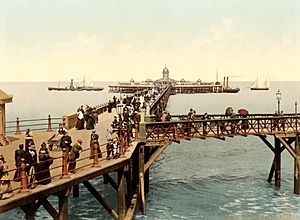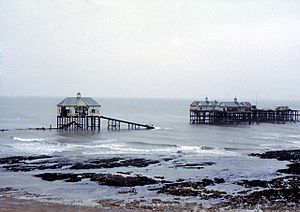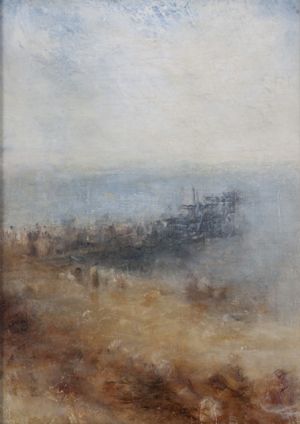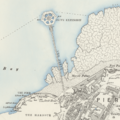Margate Jetty facts for kids

A c. 1897 depiction of the pier
|
|
| Type | Victorian pleasure pier, steamboat jetty |
|---|---|
| Carries | Pedestrians |
| Spans | The Bay |
| Locale | Margate, Kent |
| Owner | Margate Pier Harbour Company |
| Total length | 1,100 feet (340 m) (wooden pier) |
| Opening date | 1855 (iron pier) |
| Destruction date | 1976 |
| Coordinates | 51°23′41″N 1°22′49″E / 51.3947°N 1.3804°E |
The Margate Jetty, also called Margate Pier, was a famous pier in Margate, Kent, England. It was first built from wood in 1824. Later, it was rebuilt using strong iron in 1855. Over the years, the pier was made longer and had more parts added.
The pier closed in 1976 because it was no longer safe. Just two years later, a big storm badly damaged it. It took many years to completely remove the pier, with some parts remaining until 1998.
Contents
Building the Wooden Pier
The very first pier at this spot was a long wooden structure. It was built in 1824 by the Margate Pier Harbour Company. This pier was known as the Jarvis Landing Stage. It helped ships load and unload passengers. This was especially useful at low tide when Margate Harbour was too shallow for boats.
The Amazing Iron Pier
The wooden pier needed many repairs. On November 4, 1851, a storm broke it in two places. So, a new iron pier was started in 1853. This new pier was designed by a clever engineer named Eugenius Birch.
When it opened in 1855, it became the first iron seaside pier in the world! Work to finish it continued until 1857. In 1858, a special building called a pavilion was added at the end of the pier. This building was used as a station for steamships arriving and leaving.
The pier was made even longer between 1875 and 1878. This is when the unique eight-sided pierhead was added. On January 1, 1877, a shipwreck hit the pier during a storm. About 40 to 50 people were trapped on the far side of the break. They had to wait until the next day to be rescued. Later that year, on November 24, another ship hit the pier. This caused a lot of damage to the structure. More parts were added to the pier in 1893 and 1900.
In 1898, a building and a ramp were built on the pier. This allowed the Royal National Lifeboat Institution (RNLI) Margate Lifeboat Station to move there. The RNLI is a charity that saves lives at sea.
The Pier During World War II
The Margate lifeboat was one of the "Little Ships of Dunkirk". These were small boats that sailed to France in May-June 1940. They helped with Operation Dynamo. This was a huge rescue mission to evacuate British and French soldiers. These soldiers were stuck on the beaches of Dunkirk as German forces advanced.
In 1940, parts of the pier's wooden surface were removed. This was done to stop any invading German army from using it. Later, the surface was put back. The pier was then used to load Allied troops and supplies. After the war, the pier went back to being a steamship jetty. The last steamship trips happened in 1966. The pavilion building was badly damaged by fire in 1964. Finally, the Margate Jetty closed in 1976 because it was no longer safe.
The Storm That Destroyed the Pier
A huge storm, called a storm surge, hit on January 11–12, 1978. This storm destroyed most of the pier. It washed pieces of the pier onto the beach. The RNLI station on the pier was cut off by the damage. A helicopter from the RAF Search and Rescue Force flew a lifeboat crew to the station. They launched the lifeboat and took it to Ramsgate Lifeboat Station. A new RNLI station was later built at Margate Harbour, where it is still used today.
The wooden wreckage of the pier was burned on the beach after the storm. However, some local people saved parts of it. Large sections of the pier were still standing. Attempts to demolish them continued for years. More than 12 controlled explosions were used to break down parts of the structure. The very last pieces were finally removed in 1998.
Some items from the pier are kept at Margate Museum. These include the entrance sign and parts of the railings and deck. The museum also has other items related to the pier. Other salvaged pieces can be found around the town. In 2007, a fundraising effort began to collect money to rebuild the pier. In summer 2018, an art display was put up where the pier used to start. It looked like a horseshoe-shaped lifebuoy with the words "Save Yourselves" on it.
The Pier in Art
The famous artist J. M. W. Turner lived in Margate for a while. He painted a sketch of the jetty, which he could see from his window. It is thought that this painting got damaged and was rolled up. Later, a part of the canvas was cut off. In 1910, a small piece was bought by Gwendoline Davies.
In 1952, Davies gave this painting to National Museum Wales. In 1956, experts thought it wasn't by Turner, but just in his style. However, in 2012, a new look at the painting changed their minds. They decided the brushwork and colors were typical of Turner's later works. So, it was officially recognized as a painting by him.
Images for kids







